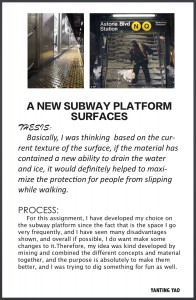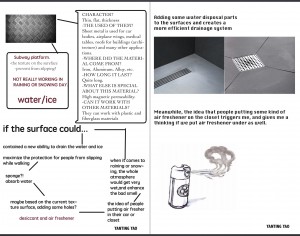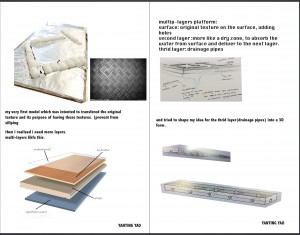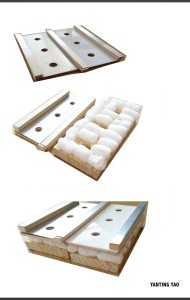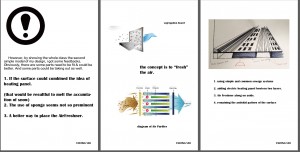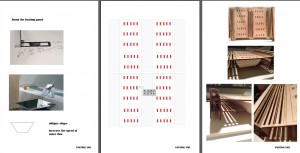When I think about the word “Surface”, I was actually thinking about the world surface, the exterior space, we are in the surface of Earth, we live in this surface. However, surface as a material, that is also very common in our life, every thing you touched is a surface, every object you seen is has a surface. For this assignment, I have developed my choice on the subway platform since the fact that is the space I go very frequently, and I have seen many disadvantages shown, and overall if possible, I do want make some changes to it.
First of all, I began this project by simply random chose 10 surfaces: something that was really common to be seen, like metallic sheet which I further develop into subway platform, glass, Ceramic; or some surfaces of an object that involve high technology and scientific theories, like Maglev train, vacuum bottle, Macbook, sneakers and LED light; and there also got be something related to my major as Fashion Design, like Fur, leather and wool. And I did some research, and they all have some disadvantages. I narrow them down and made few designs for bridge 2: either borrowed the original purpose of the surfaces and creates a new form, or mixed the advantages from one thing into another. Mixing and combined the different concepts of each one, my purpose is absolutely to make them better, and I was trying to dig something for fun as well. For instance, I have got inspirations from the research of Vacuum bottles. Research shows that the main idea of Vacuum bottle is to block the air: the gap between the two flasks is partially evacuated of air—creating a near-vacuum which prevents heat transfer by conduction. As while I was doing research for LED light, I found out that the biggest disadvantage of LED light is that they are so influenced by temperature. So combined the advantage of Vacuum bottle and the disadvantage of LED light, my idea was to borrow the vacuum idea to create a vacuum layer and adding it to LED blubs in order to maximally keep the temperature for the light blub.
I really like that idea; however, moving to bridge3, in order to make a makeable product via 3D printer or hand making, I decided not to develop my further study on this one, really because making a near-vacuum zone for a light blub involved many professional technic devices and knowledge which was limited for me as a college student. So, for bridge 3, I decided to have fun with metallic surfaces. As mentioned before, I also have done research about these surfaces. I have noticed that normally there would always have some textures on many metallic surfaces, like it usually appeared on subway platform or stairs, which probably is used to prevent people from slipping. However, from my personal experiences, they are not really working so well. I chose subway platform as an example. Due to the fact that there are usually many people in rush hours walking though, and which makes the space very crowded, typically when it is snowing or raining, water and ice flush in everywhere, so people still got slipped. From this point, I kind got something to develop. Basically, I was thinking that based on the current texture of the surface, if the material has contained a new ability to drain the water and ice, it would definitely helped to maximize the protection for people from slipping while walking in those tough days. Also, I noticed that when it comes to raining or snowing, the whole atmosphere would get very wet, especially in the underground subway, and it enhanced the typical “subway” smell. Perhaps this new material could sort of change that situation by adding some solid like desiccants. The idea that people putting some kind of air freshener on the closet triggers me, and gives me a thinking if we put air freshener under as well.
So I made a model and sketch. Basically, the first layer maintains the same texture and metallic surfaces, but more holes. Adding layers under that like sponge but mixed with desiccant and air freshener, perhaps there could add one more layer with drainage tubes. Overall, this might not be a perfect platform which could 100% solve the existed issue, but I do hope it can be more useful and helpful, and my intension was to make it better than now.
since i actually have made changes for the final presentation after i wrote this essay for Seminar, here are my process board.
